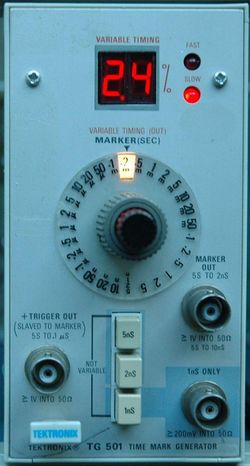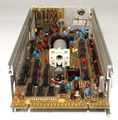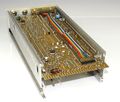TG501: Difference between revisions
No edit summary |
No edit summary |
||
| Line 1: | Line 1: | ||
{{TM500 | mfg=Tektronix | type=TG501 | function=time mark generator | class=pulse generator | image=Tek tg501 on.JPG | introduced=1974 | discontinued=1995 | | {{TM500 | mfg=Tektronix | type=TG501 | function=time mark generator | class=pulse generator | image=Tek tg501 on.JPG | introduced=1974 | discontinued=1995 | | ||
manuals= | |||
* [ | * [[Media:070-1576-02.pdf|Tektronix TG501 Manual]] (OCR, stitched schematics) | ||
* [[Media:TG501 schematics.pdf|Tektronix TG501 Schematics | * [[Media:TG501 schematics.pdf|Tektronix TG501 Schematics, stitched]] | ||
}} | }} | ||
There is also a TG501A. | There is also a TG501A. | ||
Note the [ | Note the [https://www.eevblog.com/forum/repair/tektronix-tg501-out-put-problem/ output must be terminated into 50 Ω] or there may be no signal at all. | ||
{{BeginSpecs}} | {{BeginSpecs}} | ||
| Line 16: | Line 16: | ||
{{Spec | External Reference Input | 1 MHz, 5 MHz or 10 MHz; TTL compatible (internally hard wired so output frequencies counted down to 1 MHz) }} | {{Spec | External Reference Input | 1 MHz, 5 MHz or 10 MHz; TTL compatible (internally hard wired so output frequencies counted down to 1 MHz) }} | ||
{{EndSpecs}} | {{EndSpecs}} | ||
==Rear Interface Signals== | |||
{| class="wikitable" | |||
|- | |||
! colspan="2" | Connector Pin | |||
! rowspan="2" | Description | |||
|- | |||
! Signal | |||
! Return | |||
|- | |||
| 28A || 27A || Marker Out (requires front BNC disconnection) | |||
|- | |||
| 27B || 28B || Trigger Out (requires front BNC disconnection) | |||
|- | |||
| 25A || 26A || Internal 1 MHz Clock Out (TTL) | |||
|- | |||
| 24B || 25B || External Clock Input | |||
|- | |||
| 26B || 22B || Data Good (High when BCD data valid) | |||
|- | |||
| 17A..20A || 22B || bit 4..1 BCD Display data, MSD | |||
|- | |||
| 21A..24A || 22B || bit 4..1 BCD Display data, LSD | |||
|- | |||
| 16A || 22B || Fast=Low, Slow=High | |||
|} | |||
==Internals== | |||
The TG501 internally produces a 1 MHz reference clock, either from an internal crystal oscillator, or from an externally supplied frequency. | |||
A 100 MHz VCO is phase-locked to this reference frequency (in fixed-frequency mode) or to the output of a variable 1 MHz astable multivibrator (in variable frequency mode). | |||
When the variable oscillator is in use, its frequency is digitally compared to the fixed 1 MHz reference and displayed as a deviation in percent with a pair of LEDs indicating the sign (fast or slow). | |||
A chain of dividers running off the 100 MHz clock provide the selectable output markers. | |||
==Links== | ==Links== | ||
* See the [[TG501/Repairs]] page for repair information. | |||
* [https://www.youtube.com/watch?v=U5LQpqwqNIU Tek TG501A Time Mark Gen Restoration] by NFM @ YouTube | * [https://www.youtube.com/watch?v=U5LQpqwqNIU Tek TG501A Time Mark Gen Restoration] by NFM @ YouTube | ||
* [https://www.youtube.com/watch?v=FIe9WzdIZ9g TG501 Repair and Calibration] by Zenwizard Studios @ YouTube | |||
* [https://www.youtube.com/watch?v=FIe9WzdIZ9g | * [https://www.youtube.com/watch?v=rF5V7D0VZeE TG501 In-Depth Troubleshooting of a Stubborn Unit] by Zenwizard Studios @ YouTube | ||
* [https://www.youtube.com/watch?v=rF5V7D0VZeE | |||
==Pictures== | ==Pictures== | ||
===TG501=== | |||
<gallery> | |||
Tek tg501 on.JPG | TG501 early version | |||
Tg 501 late.jpg | TG501 late version | |||
Tek tg501 internal1.jpg | |||
Tek tg501 internal2.jpg | |||
Tek tg501 internal3.jpg | |||
Tek tg501 internal4.jpg | |||
Tek tg501 internal5.jpg | |||
Tek tg501 internal6.jpg | |||
Tek tg501 internal7.jpg | |||
Tek tg501 early left.jpg | TG501 early version | |||
Tek tg501 early right.jpg | TG501 early version | |||
Tek tg501 waveform.jpg | TG501 output waveform | |||
</gallery> | |||
===TG501A=== | |||
<gallery> | <gallery> | ||
Tek tg501a.jpg | |||
Tek tg501a.jpg | |||
</gallery> | </gallery> | ||
[[Category:Time mark generators]] | [[Category:Time mark generators]] | ||
Revision as of 13:02, 10 December 2021
The Tektronix TG501 is a time mark generator plug-in for the TM500 system.
There is also a TG501A.
Note the output must be terminated into 50 Ω or there may be no signal at all.
Key Specifications
| Interval | 1 ns to 5 s in 1−2−5 sequence |
|---|---|
| Timing accuracy | Stability 1×10-5, long-term drift 1×10-5 per month (with Option 1, 5×10-7 / 1×10-7 per month) |
| Error Readout | Accuracy 1 digit (±0.1% points), Range to ±7.5% |
| Amplitude | ≥1 V peak on 5 s through 10 ns; ≥750 mVp-p on 5 ns and 2 ns; ≥200 mVp-p on 1 ns (separate output) (all into 50 Ω) |
| Trigger Output | Slaved to marker output from 5 s through 100 ns. Remains at 100 ns for all faster markers |
| External Reference Input | 1 MHz, 5 MHz or 10 MHz; TTL compatible (internally hard wired so output frequencies counted down to 1 MHz) |
Rear Interface Signals
| Connector Pin | Description | |
|---|---|---|
| Signal | Return | |
| 28A | 27A | Marker Out (requires front BNC disconnection) |
| 27B | 28B | Trigger Out (requires front BNC disconnection) |
| 25A | 26A | Internal 1 MHz Clock Out (TTL) |
| 24B | 25B | External Clock Input |
| 26B | 22B | Data Good (High when BCD data valid) |
| 17A..20A | 22B | bit 4..1 BCD Display data, MSD |
| 21A..24A | 22B | bit 4..1 BCD Display data, LSD |
| 16A | 22B | Fast=Low, Slow=High |
Internals
The TG501 internally produces a 1 MHz reference clock, either from an internal crystal oscillator, or from an externally supplied frequency.
A 100 MHz VCO is phase-locked to this reference frequency (in fixed-frequency mode) or to the output of a variable 1 MHz astable multivibrator (in variable frequency mode). When the variable oscillator is in use, its frequency is digitally compared to the fixed 1 MHz reference and displayed as a deviation in percent with a pair of LEDs indicating the sign (fast or slow).
A chain of dividers running off the 100 MHz clock provide the selectable output markers.
Links
- See the TG501/Repairs page for repair information.
- Tek TG501A Time Mark Gen Restoration by NFM @ YouTube
- TG501 Repair and Calibration by Zenwizard Studios @ YouTube
- TG501 In-Depth Troubleshooting of a Stubborn Unit by Zenwizard Studios @ YouTube
Pictures
TG501
-
TG501 early version
-
TG501 late version
-
-
-
-
-
-
-
-
TG501 early version
-
TG501 early version
-
TG501 output waveform













